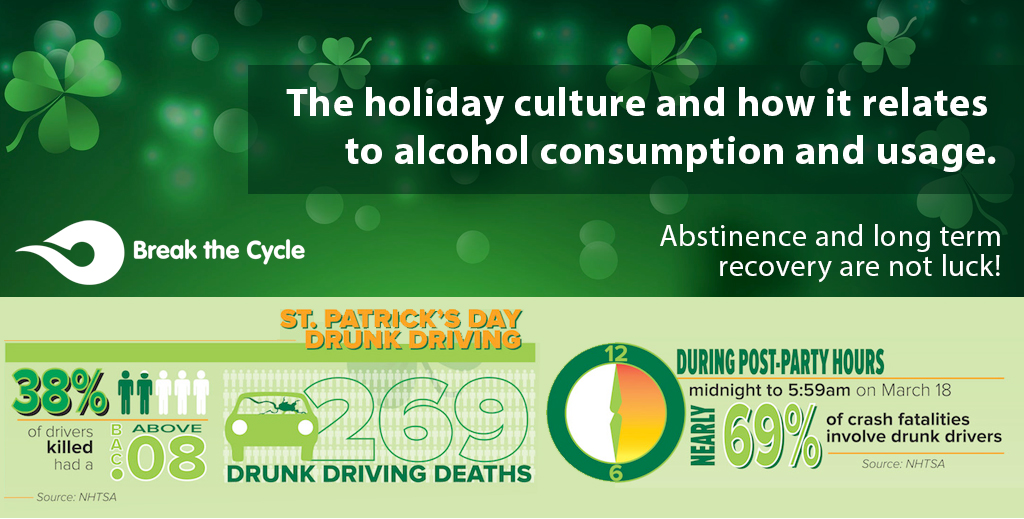
St. Patrick’s Day is known for celebrating Irish heritage with big parades and events around the United States. However, St. Patrick’s Day is also the third most popular “drinking holiday” in America. March 17th closely follows New Year’s Eve and July Fourth, when it comes to alcohol consumption. Therefore, it is safe to say that certain holidays put heavy emphasis on drinking alcohol. A wise person, sober for a long time, once stated, “If you go to the barbershop long enough…you are going to end up with a haircut!”
That doesn’t mean that individuals in recovery from alcohol or substance use disorder (alcoholism, etc.) have to live sheltered lives and avoid holiday celebrations. In a very popular book, Alcoholics Anonymous, the authors believe that “any scheme of combating alcoholism which proposes to shield the sick man from temptation is doomed to failure. If the alcoholic tries to shield himself he may succeed for a time, but he usually winds up with a bigger explosion than ever” (Alcoholics Anonymous p. 101). That means that hiding or avoiding alcohol doesn’t necessarily offer a way to long-term recovery. At Break the Cycle, we offer treatment services that help individuals better understand the nature of the illness and apply new “action-oriented tools” and skills that help them live with alcohol use disorder…rather than eliminate it. Break the Cycle also strongly suggests to all clients to attend regular 12-step fellowships. We have found that between treatment at Break the Cycle and engagement with 12-step fellowships…many clients find long-term recovery and success.
Here are some things to consider for enjoying holiday celebrations with a heavy emphasis on drinking alcohol:
- Always ask yourself, “Am I here for the celebration of the meaning of the holiday…or am I trying to ‘party’ without drinking?” Check your motives.
- This might be your first St. Patrick’s Day abstinent or sober –OR– you are early in recovery. Ask yourself, “What will I miss if I take a pass this year?” In reality, holidays happen at the same time every year. They aren’t going anywhere. So ask yourself if “going out” is more important than staying abstinent and sober. Again, that doesn’t mean “hide from these situations”, but there are many alternatives rather than going to familiar drinking establishments and places.
- Most holiday drinking and traffic-related incidents occur at night or in the “after-hours” of these annual events. Stay home or somewhere safe. Find new friends in 12-step fellowships or family gatherings that are safe and away from the dangers of the road.
- Family get-togethers can be just as “drinking involved” as public settings. If you are compelled to visit family, always have a method to be able to leave on your terms. Do your best not to be dependent on others for a ride. That way, you can always leave if you feel uncomfortable or have other things to attend to.
- Try your best to attend 12-step meetings regularly. By doing so, you have a place to go where drinking is not involved.
- If you are at a gathering where there is drinking and you are asked, “Why aren’t you drinking?” often the best response is “I’m sober” or “I don’t drink.” If people persist, keep it simple with your answers. You do not have to “convince” or “rationalize” your desire to be abstinent and sober to any person. Often, it has been observed that when someone is persistent in “pursuing the issue” or “hounding you about not drinking”, they might have more internal things in their own life. Again, you do not have to justify or please people who are consistently questioning your abstinence and life free from alcohol. The best practice is to be courteous, and to the point, and ultimately ask yourself, “How long do I want to stick around this environment.” It has been found that “selling our situation” or “trying to convince others” often continues to flame the discussion…rather than extinguish it.
- There is no need to “pretend to be drinking”. “Near beer”, “zero alcohol beer”, and mixed drinks without the alcohol can possibly set us up for the “real thing” rather than give the illusion that we are part of the “drinking culture”. To thine own self be true. If you want something non-alcoholic to drink…stick with a soda, water, etc. There is no need to try to fit into an environment that is fueled by alcohol.
Some Interesting Stats on St. Patrick’s Day Binge Drinking
Binge drinking on St. Patrick’s Day has dangerous and painful consequences for the families affected by it. Statistics about alcohol-related incidents include:
- Over the holiday weekend in 2019, 63% of car-related fatalities involved drunk drivers.
- In 2018, 33% of pedestrians killed in car crashes over the holiday were intoxicated with a BAC over 0.08.
- Between 2015 and 2019, 280 people were killed in drunk driving incidents during St. Patrick’s Day.
- It’s estimated that a drunk driving death occurs every 30 minutes during St. Patrick’s Day.
Binge drinking on St. Patrick’s Day takes its toll even if people aren’t behind the wheel:
- Beer sales increased by 174% on St. Patrick’s Day, while spirit sales increased by 153%.
- In 2022, it’s estimated that Americans celebrating the holiday will spend more than $42 on average, amounting to around $5.87 billion nationwide; 46% plan to purchase drinks.
- On average, drinkers consume 4.2 drinks on St. Patrick’s Day.
- Binge drinking cost the United States $191 billion in 2010 due to losses in workplace productivity, health care expenditures, criminal justice costs, and related expenses.
- Binge drinking has short- and long-term effects on your health, even if you don’t do it regularly.
